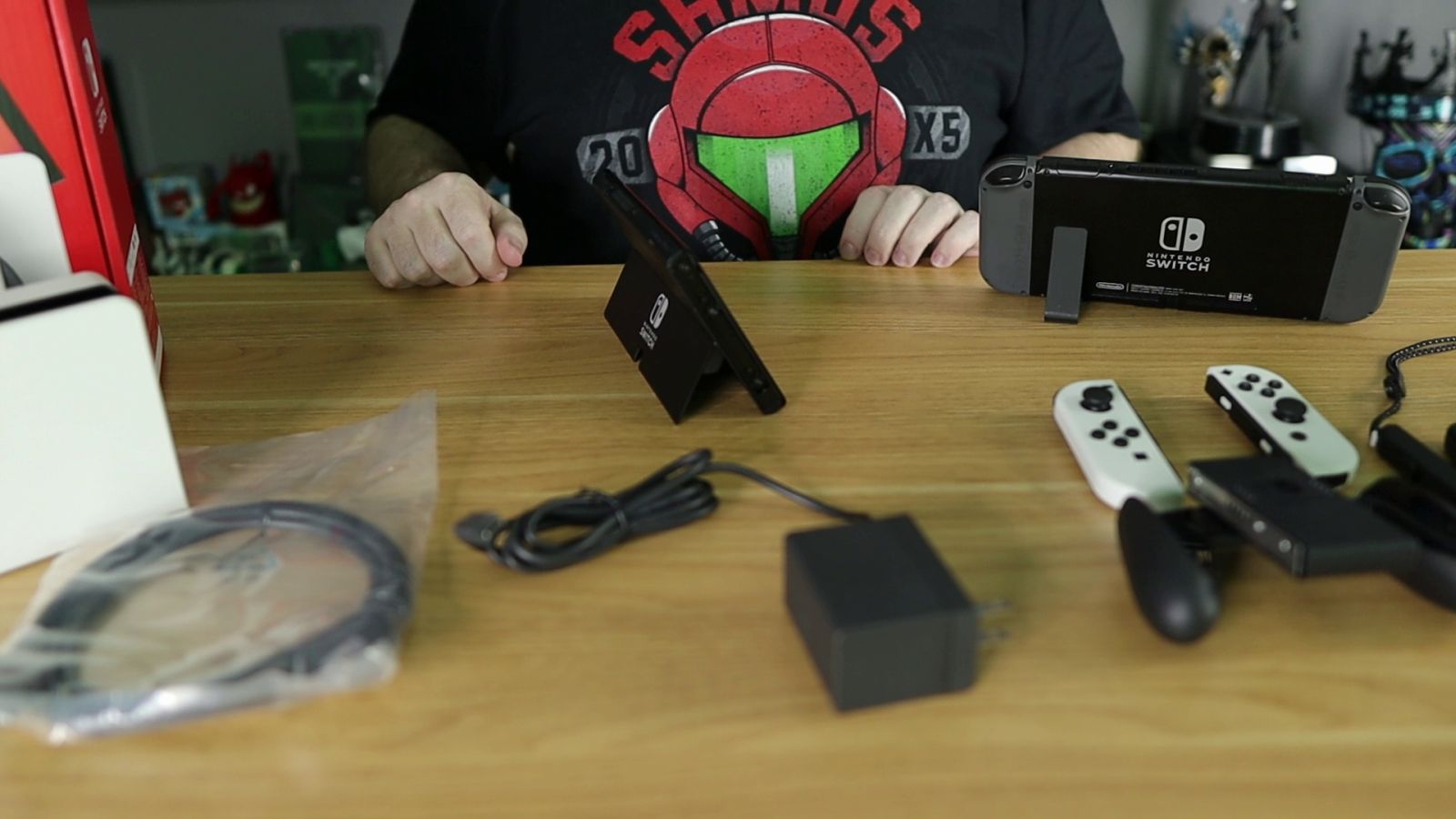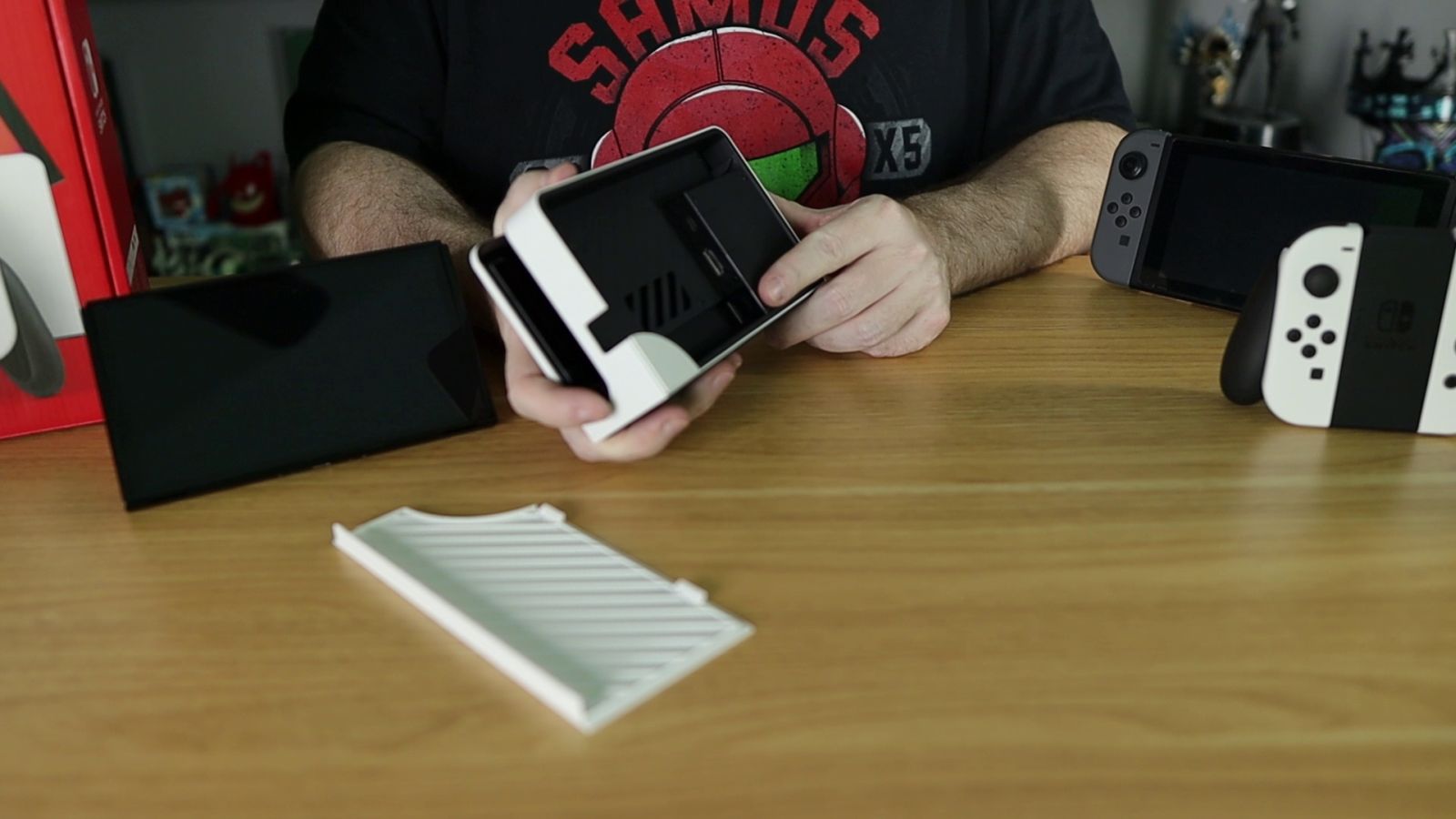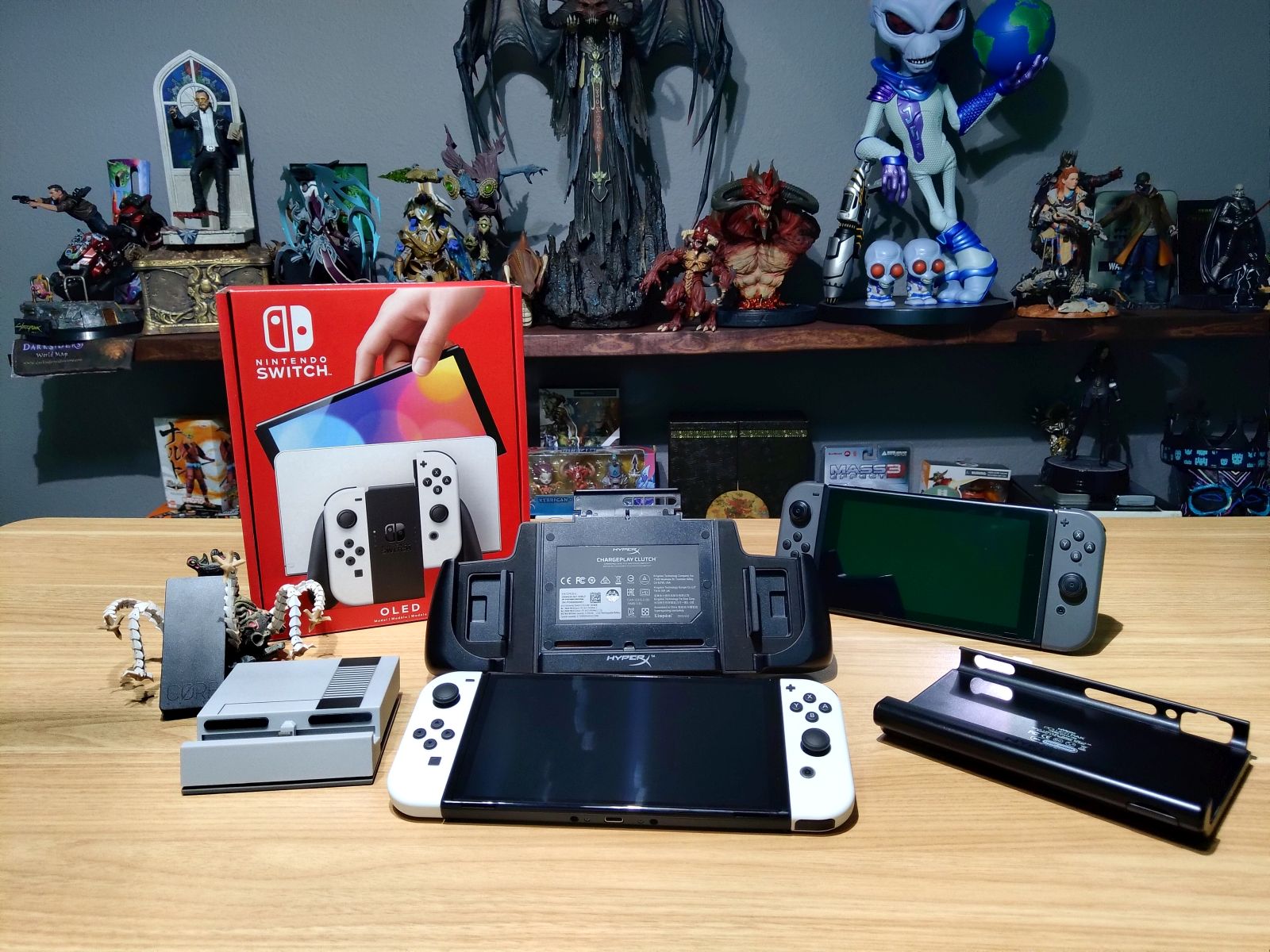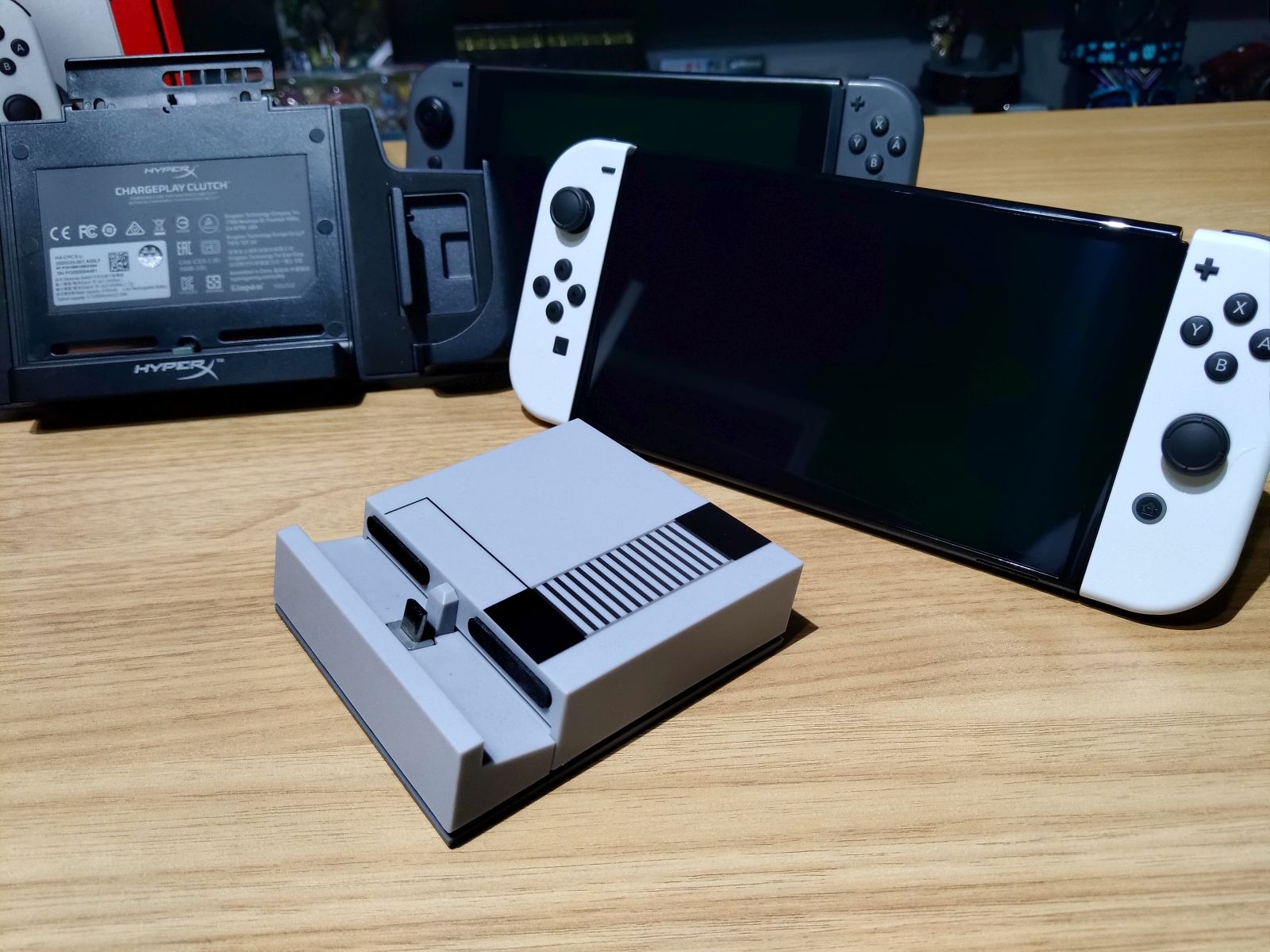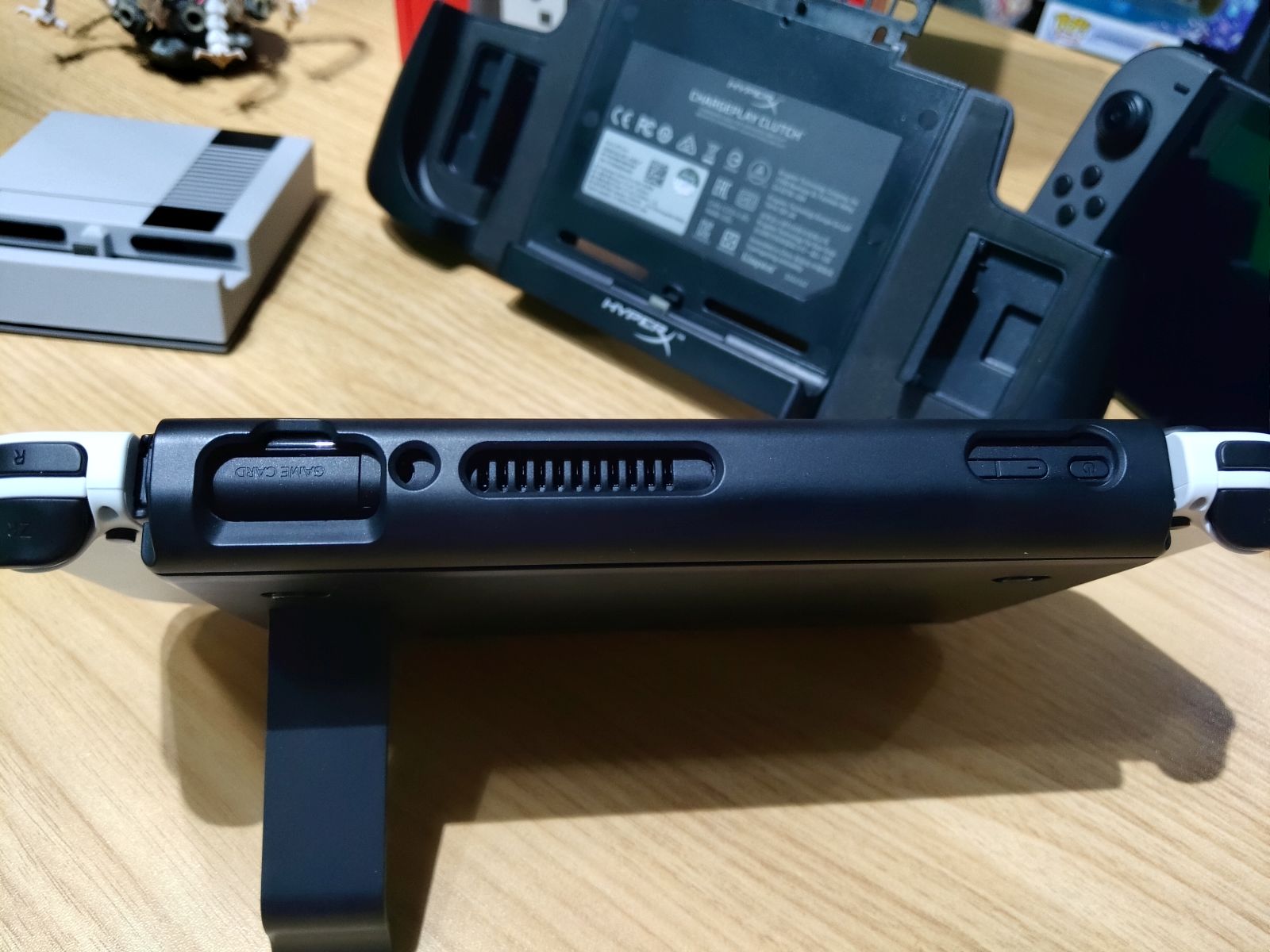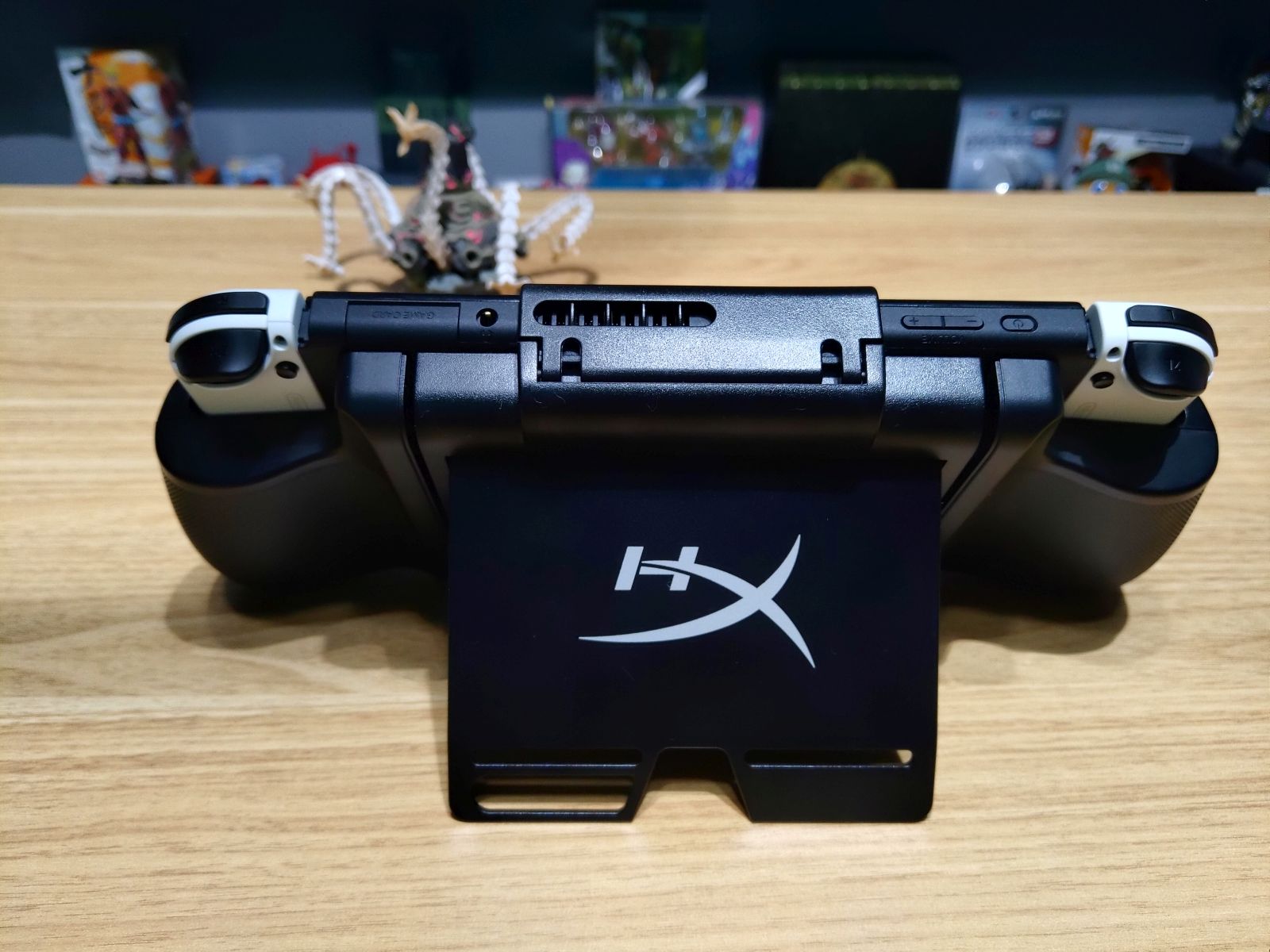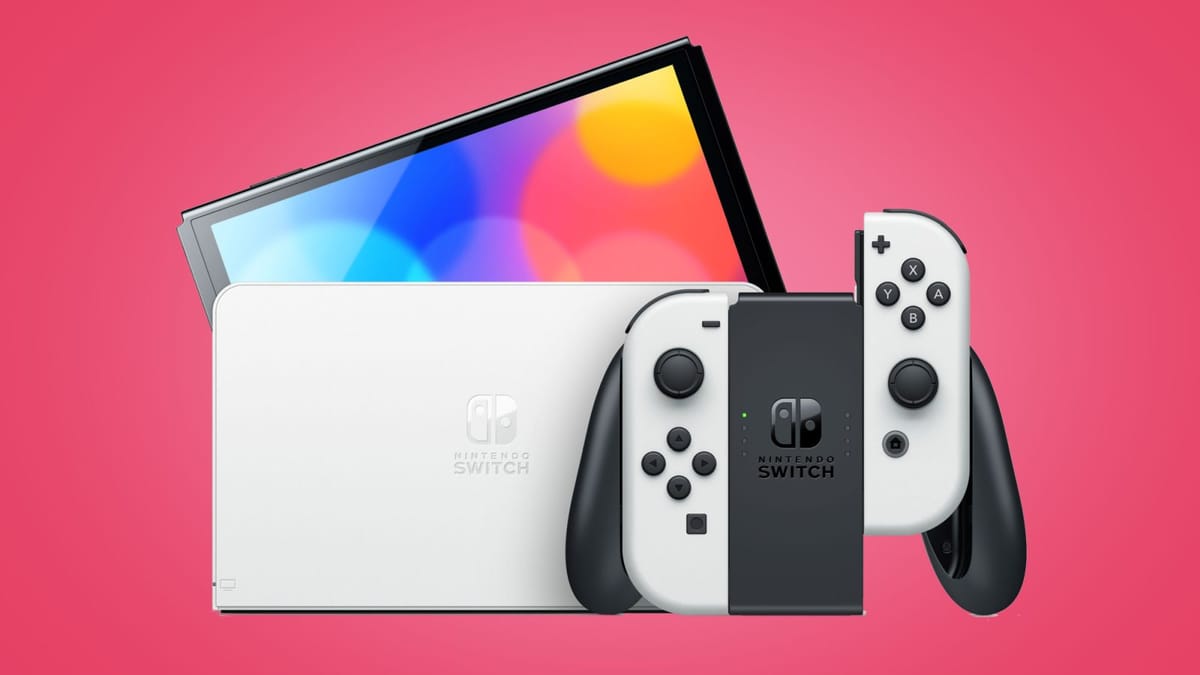
Elden Ring, Halo Infinite, Guardians of the Galaxy — there’s a LOT to be excited about this holiday season, but one of my most anticipated is Metroid Dread running on the Nintendo Switch OLED. Nintendo has had the number one selling console for literal years in a row since its launch in 2017 and, on the surface, these do look like the same console. What’s special about this console update beyond the new OLED screen, and is this new coat of paint a needed one, or merely a luxury upgrade? Without further ado, let’s open the box and get a closer look!
There are a lot of quality of life updates in this new package, despite looking nearly identical from a distance. The first is a full replacement of the kickstand system, which frankly was criminally unstable on the launch system. Gone is the easily detached plastic toothpick in the back that would collapse at the slightest nudge, replaced by a plate that extends the full width of the system, with a small notch in the center for cable routing. With this simple change the system is now rock solid on any surface. Stability is no longer a concern for the Switch. A small ridge under the kickstand makes it easy to open, even for kid-sized fingers, as an added bonus.
Other than stability, the other problem with the launch unit kickstand was that it could only be placed in a single position. Much like a Microsoft Surface, the kickstand on the Nintendo Switch OLED can be placed at nearly any angle, meaning you can adjust it for nearly any situation. Whether it’s avoiding a pesky light source, or getting it to stay securely on a tray table on a plane, you can now game or watch a video on the screen without having to use an Amiibo to prop it up at the right angle.
The SD Card slot on the Switch was tucked behind the kickstand on the original switch, and that hasn’t changed here. Moved to an East-West orientation instead of a North-South one, the SD Card slot is recessed at an angle for easier removal, but still protected by the body of the unit itself.
Aesthetically, the buttons on the top of the unit itself have changed, though you likely wouldn’t notice if I didn’t point it out. The power button has changed from a circular one to a rounded-edged rectangle, and the volume rocker is slightly smaller than the original. It’s a cosmetic upgrade to be sure, though the more recessed power button also feels like it could deftly avoid accidental presses on pickup.
The Joy-Cons included with the OLED Switch are white, just like the new dock, though you are not bound to use them. In fact, every Joy-Con since launch, including Japanese ones, will work with this new console, and the white ones will work on your old hardware. If you want to mix and match, you are free to do so. For me, I’m happy with the clean black and white aesthetic. The system ships with a Joy-Con holder that is identical to the launch one, meaning you can leave it in the box if you are upgrading from an old unit. All of that said, while I’ve had no issues with drift myself, these new Joy-Cons could potentially have the same issues others have had.
Let’s talk about the dock, as there are some big changes here. The unit is now bevel edged, meaning all of the sharp angles of the launch dock are gone. Two USB ports lie in front, just like the original, but that third that was tucked inside is gone, replaced by a gigabit ethernet RJ-45 port. An ethernet dongle would run you $30, and is frankly an unsightly thing hanging off the old dock. This new OLED Switch comes with a $50 price bump, so this new port represents 3/5 of that cost. What it also represents is a marked improvement in latency and speed.
Even if you are using a state of the art router capable of shoving gigs of data around through the air, you are subject to Murphy’s Law. Whatever can go wrong will go wrong, and at the most inopportune time. Just when you are about to pull off that critical combo to bounce your opponent off the map in Super Smash Bros, your little brother will decide to test out his new walkie-talkies. Right as you launch your shell to take out the leader to zip into first place in Mario Kart 8, your mom will decide to grab the latest update to her iPad on your shared wireless connection. It’s inevitable. Well, now you can avoid at least some of that with a more reliable and stable wired connection directly to the dock. At least while you are playing in docked mode, you’ll be able to do so with a bit more confidence that Murphy’s Law won’t be as frequent a factor. In practice I found that my update speeds were far more consistent, and they started a little faster as the handshake process with my router initiated almost instantly. It resulted in downloads that were easily cut in half compared to the wireless option.
Reaching this new RJ-45 port is now a little easier, though I’m eager to hear what you folks think about the new removable backplate. Rather than a door that swings open and remains attached, the entire plate can now be removed. I personally prefer this as it means I’m not fiddling with the dangling door while I try to finesse cables into place, but I can see where opinions may vary. That said, I think we’ll all agree that this removable backplate feels a little more flimsy than its predecessor.
Access to cabling is accomplished with a new cable channel. The jury is out whether this is better or equivalent to the original, but I like the new space on top as it grants a little more heat dissipation room as well as another area to route cables if needed.
One last much-needed change was made to the dock for this OLED version — a little more breathing room. I use a screen protector on my older switch simply because the old dock was prone to scratching the touchscreen, as evidenced by the nicks on the surface. The new dock has a few millimeters of extra space to try to prevent accidental bumps and nicks as you drop the system into place. It’s another subtle but very necessary feature update on this new model.
Right out of the box, the Switch OLED is able to connect to my Razer Hammerhead wireless earbuds. With an update, my older Switch was able to do the same thing. It’s a welcome update, but not one you’ll have to buy this new console to accomplish. I was using a Genki Bluetooth adapter jammed into the USB-C slot on the bottom to do this before, or I was until I lost the chunky thing. It’s nice to be able to do it natively on both units now. Thanks Nintendo!
This Switch update would have been a grand opportunity to bump the battery life on the console, but my tests over the last week have revealed almost no difference. Comparable with the launch unit, my in-use time seems to be roughly 5 hours.
Testing the new OLED Switch with a few accessories, I found a bit of a mixed bag, though that’s obviously no fault of Nintendo. The Nyko Power Pak is an easy to use attachment that simply clamps over the rear of the original Switch. Thanks to some adjustment buttons, it will just barely fit on the new OLED Switch, connecting and working mostly as intended. I say mostly as it partially obstructs some of the buttons, as well as the 3.5mm audio jack. That said, there’s no way I’d recommend it as the kickstand on that unit may be somehow even worse than the original — hard pass, even if the battery life is more than doubled.
On the flip side, HyperX has a Chargeplay Clutch which works very well. The clamp over the top doesn’t come near the buttons or ports in any way, and the kickstand in the back is very similar to what Nintendo has done. The detachable grips on the sides do pick up a 1-2mm gap with the additional width of the console, but otherwise it does exactly what it’s supposed to do. All of this to say that your mileage may vary a bit with accessories for your new OLED Switch. Caveat emptor.
One of the first things you should pick up when you buy a Switch is an SD Card as the internal storage of 32GB on the original just filled up entirely too fast. Well, the OLED moves the bar a little bit, doubling that size, games like NBA 2K20 being 33GB, NBA 2K19 at 32GB, L.A. Noire at 27.4GB, Mortal Kombat 11 at 22.5GB, DOOM at 21.7GB, and Fortnite at 11.2GB being some of the larger titles will eat up space rather quickly. The average game size is around 8GB so plan accordingly if you’ve got plans to keep multiple games installed.
Saving the best for last, let’s talk about the OLED screen. Measuring 7”, it’s bigger than both the 6.2” screen on the launch system, and far bigger than the 5.5” Switch Lite. Better still, the bezels are significantly smaller, meaning more screen real estate for gaming. The original Switch screen is a hard plastic, which I’ve covered with a protective cover. On the OLED version, the surface is glass and comes ready to go with an anti-scattering adhesive film. I’m still going to end up putting a screen cover on top, but you don’t want to remove this film. It even says so in the manual…not like you probably would read that or anything.
In terms of software, the two consoles are almost identical, though the OLED version comes with a setting called “Console-Screen Colors”. This setting is meant to punch up the brightness and color saturation, especially in your softer color palette. As is often the case with OLED televisions that have similar technology, this can lead to some colors being over-saturated, especially in already-pastel styled games like Animal Crossing, but wow does it do amazing things for games like Metroid Dread and Mario Kart 8. Either way, thankfully it’s a toggle so you can use it when you want it, and turn it off when you don’t.
There’s no way a camera can capture how much of an upgrade this new screen really is, despite my best efforts, but it’s significant. The overall brightness and just a general crispness of the image quality is a marked upgrade over the original. With all of these upgrades, the question then becomes whether or not it’s worth it. Well…that depends. If your Switch lives in your dock, you can safely skip this one. If you are mostly a handheld player, then this is a must-have. While this update doesn’t give any additional memory or processing power, it does bring a number of very worthwhile quality of life upgrades that come together for a very solid mid-cycle upgrade for gorgeous gaming on the go.
Nintendo Switch OLED
Excellent
Numerous quality of life upgrades combined with a gorgeous OLED screen gives the Nintendo Switch a fresh coat of paint that should hold us until Nintendo makes us fall in love with whatever comes next!
Pros
- 7” OLED screen is gorgeous and bright
- Ethernet provides more reliable connectivity
- Dock redesign should mean less scratches
- 64GB of internal storage
- Kickstand is almost worth the upgrade!
Cons
- Console-Screen Colors setting may wash out softer colors
- Extra 3mm size may invalidate some 3rd party accessories

